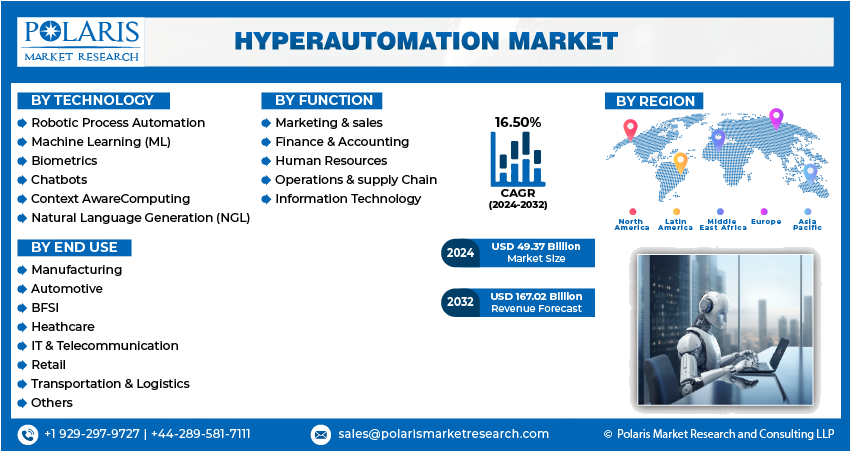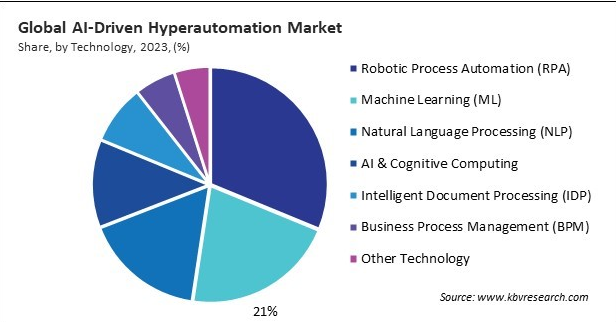Introduction
Introduction
Did you know? Hyperautomation is a strategic priority for 90% of large enterprises, emphasizing its critical role in digital transformation initiatives. In today’s rapidly evolving digital landscape, businesses are not just striving for growth they’re racing to stay agile and future-ready. Manual processes, siloed systems, and disconnected workflows are no longer sustainable in a competitive digital economy.
Hyperautomation has emerged as the game-changing strategy that enables enterprises to evolve rapidly and intelligently. At its core, hyperautomation isn’t just about automating tasks it’s about orchestrating technologies to transform your entire operation, from the inside out.
So, what is hyperautomation, really? But how does it pave the way for remarkable business growth and peak operational performance?
Let’s explore this transformative concept, break it down into practical insights, and understand how Futurism Technologies can help you lead the charge.
What is Hyperautomation?
What is Hyperautomation?
Hyperautomation centers on purposefully combining advanced digital technologies such as:
…to streamline and enhance as many business operations as possible.
Unlike traditional automation which focuses on repetitive tasks hyperautomation connects entire workflows, learns continuously from data, and evolves with your business needs.
It’s a layered, intelligent ecosystem that turns scattered, manual processes into a unified, self-improving digital backbone. According to market research the U.S. The hyperautomation industry, currently estimated at $14.14 billion, is projected to surge to $69.64 billion by 2034, with a compound annual growth rate (CAGR) of 17.28%.

Source: grandviewresearch
Key Characteristics of Hyperautomation
Key Characteristics of Hyperautomation
Let’s break down what sets hyperautomation apart:
1. End-to-End Automation
Rather than automating isolated tasks, hyperautomation focuses on full process automation spanning departments, systems, and user touchpoints.
2. Data-Driven Decision Making
With
AI and ML, hyperautomation doesn’t just do what it's told it learns, predicts outcomes, and improves over time.
3. Integration-First Mindset
Hyperautomation unifies different tools, applications, and platforms to deliver seamless digital workflows.
4. Human-in-the-Loop Collaboration
Contrary to the fear of replacing people, hyperautomation enhances human potential freeing teams to focus on creativity, innovation, and problem-solving.
Why Hyperautomation is a Business Imperative
Why Hyperautomation is a Business Imperative
The reality is simple companies that fail to evolve risk falling behind in today’s competitive landscape. Hyperautomation helps enterprises:
- Stay agile in a changing market
- Reduce operational costs
- Minimize errors
- Boost customer satisfaction
- Scale without extra headcount
Here’s how these benefits play out in practice.
Top Benefits of Hyperautomation
1. Productivity at Scale
By automating time consuming tasks, employees can redirect energy toward strategic goals whether it’s innovation, client experience or process improvement.
2. Reduced Operational Costs
Replacing manual workflows with intelligent automation drastically cuts down on overhead, errors and process inefficiencies.
3. Operational Resilience
With systems that can adapt and self correct, businesses become more resilient to disruptions, market volatility and customer demand spikes.
4. Enhanced Analytics and Forecasting
5. Better Customer Experience
Automated customer service, personalized messaging, and reduced wait times lead to happier, more loyal customers. Guess what? By aligning hyperautomation tools with revamped business processes, companies can cut operational expenses by up to 30%.

Source: polarismarketresearch
Core Technologies Behind Hyperautomation
Core Technologies Behind Hyperautomation
To really understand hyperautomation, you need to know the building blocks:
1. Robotic Process Automation (RPA)
Handles routine, rules-driven activities like processing invoices, entering data, and onboarding new customers.
2. Intelligent Technologies - AI and ML
Adds decision-making power.
AI analyzes data, learns from it, and adapts processes in real-time.
3. Process Mining and Task Mining
These tools analyze existing workflows to identify inefficiencies and pinpoint automation opportunities.
4. Business Process Management (BPM)
Structures and orchestrates processes, ensuring they’re optimized and compliant.
5. Low-Code/No-Code Platforms

Source: grandviewresearch
How to Build a Hyperautomation Strategy
How to Build a Hyperautomation Strategy
Implementing hyperautomation isn’t a one-size-fits-all approach. Here’s how we recommend building a winning strategy:
Step 1: Assess and Prioritize
Begin by thoroughly evaluating your organization’s workflows and operations. Identify high-volume, repetitive, and error-prone tasks. Tools like process mining help here.
Step 2: Define Objectives
What’s the endgame? Whether its cost reduction, faster service, or compliance knowing your goal helps tailor your tech stack.
Step 3: Select the Right Technologies
Opt for technologies that seamlessly align with your current infrastructure to ensure smooth integration and minimal disruption. Avoid tech silos.
Step 4: Implement in Phases
Start small automate a single process or department. Use lessons learned to scale intelligently across the enterprise.
Step 5: Measure and Optimize
Track KPIs like turnaround time, error rate and ROI. Leverage insights to consistently refine and enhance the system’s performance.
Real-World Hyperautomation Use Cases
Real-World Hyperautomation Use Cases
Let’s explore how businesses are using hyperautomation to gain a competitive edge.
- Patient intake automation
- Insurance claims processing
- AI-assisted diagnosis
Financial Services
- Loan origination and credit checks
- KYC and compliance automation
- Fraud detection using ML
Retail and E-Commerce
- Inventory and supply chain optimization
- Personalized customer engagement
- Automated returns and refunds
- Predictive maintenance
- Quality assurance automation
- Smart inventory forecasting

Source: researchnester
Challenges to Watch Out For
Challenges to Watch Out For
No transformation is without hurdles. Common challenges include:
- Resistance to change from internal teams
- Poorly defined automation goals
- Inadequate governance
- Integration issues with legacy systems
But with a solid partner and a clear roadmap, these barriers can be overcome.
Why Choose Futurism Technologies for Hyperautomation?
Why Choose Futurism Technologies for Hyperautomation?
At Futurism Technologies, hyperautomation isn't just a service it's a strategic partnership. We don’t just deploy tools we engineer intelligent, future-ready ecosystems that drive sustainable business growth.
With over two decades of digital transformation expertise, we’ve helped hundreds of enterprises across the U.S. and worldwide streamline operations, accelerate innovation, and reduce costs through cutting edge automation.
Here’s what sets us apart:
Extensive Experience Across the Entire Automation Spectrum
Our experts bring a wealth of industry-specific insight and advanced technical skills in:
- AI and Machine Learning
- Robotic Process Automation (RPA)
- Intelligent Document Processing (IDP)
- Business Process Management (BPM)
- Low-code/No-code platforms
- Cybersecurity for automation environments
We have hands on experience implementing hyperautomation across industries like healthcare, banking, manufacturing, insurance, and retail.
Tailored, Outcome-Driven Solutions
No two businesses are the same so why settle for off-the-shelf automation?
We take a consultative approach to understand your operational landscape, process maturity, and business objectives. Whether it's automating invoice processing or reimagining your entire customer support workflow, we design customized automation roadmaps aligned with your KPIs.
End-to-End Delivery and Continuous Innovation
From initial discovery and process mining to implementation, optimization, and managed services we provide complete hyperautomation lifecycle management.
Need to scale? Update processes? Integrate with legacy systems? We're with you every step of the way, offering 24/7 support and flexible delivery models, including hybrid, cloud, and on premise.
Measurable Business Outcomes, Not Just Technology
We don't just talk about ROI we deliver it. With our hyperautomation initiatives, clients have seen:
- Up to 65% cost savings in back-office operations
- 50% reduction in process turnaround time
- 30%+ improvement in customer satisfaction metrics
Our data-driven dashboards and ongoing performance tracking ensure that you're always moving toward tangible, measurable success.
Secure and Scalable Automation
Security is non-negotiable. All our automation deployments are fortified with advanced
cybersecurity frameworks, ensuring data protection, regulatory compliance, and governance without compromising speed or scalability.
A Global Team with a Local Focus
With delivery centers across the globe and a strong U.S. presence, we combine global reach with local responsiveness, ensuring timely support and unmatched agility.
The Future of Hyperautomation
The Future of Hyperautomation
Looking ahead, hyperautomation will become a cornerstone of the autonomous enterprise an organization that runs on self-healing, AI-driven operations.
With the rise of Generative AI, IoT, and edge computing, hyperautomation will only grow smarter and more powerful.
The question isn’t if your business should adopt hyperautomation. It’s when and how fast.
Ready to Start your Hyperautomation Journey?
Ready to Start your Hyperautomation Journey?
Hyperautomation isn’t just about doing things faster it’s about doing them smarter.
Whether you're looking to optimize one process or transform your entire enterprise,
Futurism Technologies has the expertise, tools, and vision to lead your hyperautomation journey.
Let’s talk. Get in touch with us now to book your complimentary consultation and kickstart your automation journey.
FAQs
FAQs
1. What is hyperautomation?
Hyperautomation is a business-driven approach that involves rapidly identifying, vetting, and automating as many business and
IT processes as possible. It utilizes a combination of technologies, including robotic process automation (RPA), artificial intelligence (AI), machine learning (ML), and other advanced tools to achieve this goal.
2. How does hyperautomation differ from traditional automation?
While traditional automation focuses on automating specific tasks using tools like RPA, hyperautomation extends beyond by integrating multiple technologies to automate entire processes. It emphasizes end-to-end automation,
incorporating AI and ML to handle complex decision making and adapt to changing business needs.
3. What major advantages can organizations gain by adopting hyperautomation?
Implementing hyperautomation can lead to increased work automation, enhanced collaboration across departments, improved productivity and the ability to streamline operations. It also allows employees to focus on higher-value tasks, fostering innovation and growth within the organization.
4. Which industries can benefit most from hyperautomation?
Industries such as manufacturing, healthcare, finance, retail, and insurance can significantly benefit from hyperautomation. For instance, in manufacturing, it can automate production processes and improve quality control, while in finance, it can streamline operations like trade surveillance and compliance monitoring.
5. What technologies are commonly used in hyperautomation?
Hyperautomation leverages a suite of technologies, including RPA, AI, ML, process mining, intelligent business process management suites (iBPMS), and low-code/no-code platforms. These technologies work together to automate complex business processes effectively.
6. What potential obstacles could businesses encounter during hyperautomation implementation?
Organizations may encounter challenges such as resistance to change, integration complexities, data quality issues, and selecting the right technology partners. Addressing these challenges requires clear communication, proper planning, and involving stakeholders throughout the implementation process.
7. How does hyperautomation impact the workforce?
By taking over routine and repetitive tasks, hyperautomation empowers employees to focus on higher-value work that demands creativity, critical thinking, and strategic input. It fosters a collaborative environment where humans and digital workers coexist, enhancing overall productivity and job satisfaction.
8. What steps involved in implementing hyperautomation?
Implementing hyperautomation typically involves identifying automation opportunities, developing a robust strategy, selecting appropriate technologies, and continuously monitoring and optimizing processes. Establishing well-defined objectives and engaging teams from across the organization are key drivers of a successful implementation.
9. How does hyperautomation contribute to digital transformation?
Hyperautomation accelerates digital transformation by automating complex processes, improving efficiency and enabling organizations to adapt quickly to market changes. It allows for the seamless integration of digital technologies across various business functions.
10. What is the ROI of investing in hyperautomation?
Investing in hyperautomation can yield significant returns by reducing operational costs, increasing efficiency, and enhancing customer satisfaction. Organizations often experience improved scalability and agility, leading to long-term financial benefits.
11. How does hyperautomation enhance customer experience?
By automating customer facing processes, hyperautomation ensures faster response times, personalized interactions, and consistent service delivery. It empowers businesses to deliver on customer expectations with greater speed, accuracy, and consistency.
12. What role does AI play in hyperautomation?
Artificial Intelligence is central to hyperautomation, allowing systems to analyze data, evolve through learning and respond intelligently to changing scenarios. It enhances the capabilities of automation tools, allowing for more intelligent and flexible process automation.
13. What are the future trends in hyperautomation?
Future trends in hyperautomation include the increased adoption of AI and ML, the integration of
advanced analytics, and the expansion of automation across more complex and cognitive tasks. Organizations are expected to leverage hyperautomation to achieve greater agility and innovation.



